#Luis Alberti
Explore tagged Tumblr posts
Photo



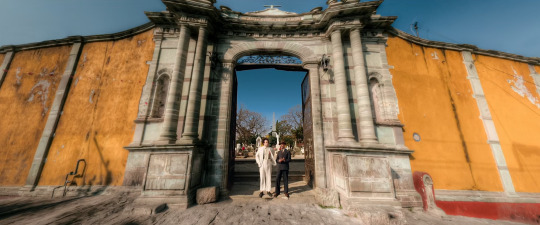
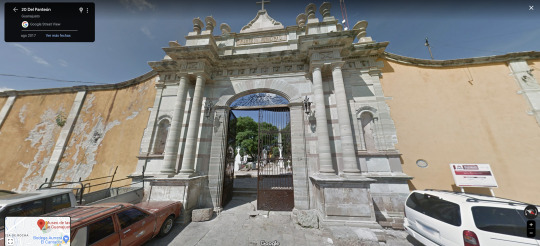
Eisenstein in Guanajuato Peter Greenaway. 2015
Cemetery Panteón Municipal Santa Paula, Explanada del Panteón Municipal s/n, Centro, 36000 Guanajuato, Gto., México See in map
See in imdb
#peter greenaway#eisenstein in guanajuato#elmer bäck#luis alberti#cemetery#mexico#Panteón Municipal Santa Paula#guanajuato#panteon#movie#cinema#film#location#google maps#street view#2015
29 notes
·
View notes
Text
Crimen sin cadáver
Crimen sin cadáver #aperturaintelectual #palabrasbajollave @tmoralesgarcia1 Thelma Morales García
#AperturaIntelectual#palabrasbajollaveAI#Arte#Barrancos de Víznar#Crimen sin cadáver#Cultura#Dibujante#Escritor y pintor Federico García Lorca#Federico García Lorca#Granada. España#Guerra Civil española#Libro "Bodas de sangre"#Libro "La casa de Bernarda Alba"#Libro "Poeta en Nueva York"#Libro "Romancero Gitano"#Libro "Yerma"#Luis Buñuel#Personajes#Poesía#Rafael Alberti#Salvador Dalí#Thelma Morales García
3 notes
·
View notes
Text

A century of the Order of thuggish and drunken knights: Lorca, Dalí and Buñuel partying in Toledo
Federico García Lorca was wrapped in a sheet stolen from the Posada de la Sangre – which disappeared in the Civil War and was the scene of Miguel de Cervantes's The Illustrious Mop –, drunk as a thief and with the desire to wander alone through the narrow streets of the old town of Toledo. Around him, some young hooligans laughed with the poet with noise and hubbub. This is how a Toledo man named Eduardo met the playwright from Granada during a Toledo night in the 1920s. At that moment, this kind man, seeing the panorama, tried to take Lorca to the relief house on Barco Street, but He flatly refused to accompany him. The poor man, of course, did not understand anything.
What this Toledoan, grandfather of the author of the space Toledo Olvidado, who is the one who told this anecdote, did not know is that Lorca was complying with one of the strict rules of the well-known Order of Toledo, a brotherhood of artists and writers related to the Generation of '27 and the Madrid Student Residence created by Luis Buñuel – calling himself Condestable – in the Venta de Aires de Toledo restaurant in March 1923.
This is how a century ago the streets of Toledo could not believe what was happening on its cobblestones. One hundred years since Buñuel, with his idea, managed to revolutionize the students of the Residence and the silent alleys of the old town of Toledo. Despite such famous components, the truth is that little or very little is known about this Order of Toledo. There is not much documentation available, beyond the stories of the protagonists themselves. Buñuel, the architect of this mischievous and intellectual action, dedicates an entire chapter to the Order in My Last Sigh, his autobiography written in his exile in Mexico.
A religious revelation and the smell of wine
«I am walking through the cloister of the cathedral, completely drunk, when, suddenly, I hear thousands of birds singing and something tells me that I must immediately enter the Carmelites, not to become a friar, but to steal the convent's treasury. The doorman opens the door for me and a friar comes. I tell him about my sudden and fervent desire to become a Carmelite. He, who has undoubtedly noticed the smell of wine, walks me to the door. The next day I made the decision to found the Order of Toledo," explains Buñuel in the aforementioned autobiography.
The rules of the Order of Toledo are strict and taken very seriously by its members. So much so that some of them even had a little problem or another in 1936, as the poet José Moreno Villa told us from Mexico, after the outbreak of the Spanish Civil War. "This order is a bit communist," thought some "men alien to letters and much more alien to irony"; although the truth is that there was only a hint of provocation in this crazy association. A normal thing among extravagant artists, somewhat dadaist, somewhat surrealist. «The starting point was to have fun, have a good time and get drunk. But it is true that, personally, I have always related what these young people did in Toledo with the historical avant-garde of the moment. I see it as the performances that the Dadaists did in Paris and Zurich, which were things that didn't make much sense, as Surrealism later adopted. In fact, it is worth noting that some members of this Order of Toledo were part of the Paris surrealist group, like Buñuel or Dalí himself,” explains Juan Carlos Pantoja, author of The Order of Toledo: imaginary avant-garde walks*.
Pantoja also details that, possibly, there were some precedents to Buñuel's Order of Toledo because "there was already a group of great intellectuals, among whom were Américo Castro, Alfonso Reyes, Antonio García Solalinde or Moreno Villa, who met in Toledo to walk at night and drink wine from 1917 onwards. He details that "they stayed in a rented house on Cárcel del Vicario street, in front of the Cathedral, and they became known as the gathering of El Ventanillo, due to the existence of a small window with views of the Valley. Buñuel says that he got to know Toledo accompanying Solalinde, so we can think that perhaps the Aragonese was at some point in these gatherings and that, from there, the idea of doing something similar arose. Pepín Bello – who left no work, but was a friend to everyone, as gallery owner Guillermo de Osma once commented –, Rafael Alberti, Dalí, María Teresa León and Federico García Lorca and his brother, among others, were part of the Brotherhood created by way improvised by Buñuel that had something of a "poetic act", according to the poet from Cádiz. And the students of the Residence were lovers of Toledo, according to Bello in an interview in 2000:« We took the train from Madrid to Toledo, we traveled in third class and it took us two hours to arrive. We went up from the station and went to drink in the taverns of Zocodover, which was very close to the Posada de la Sangre, to get into the mood a little »
Order of Toledo: drink wine and do not shower

Courtyard of the Blood Inn
Among the rules of the Order of Toledo, and which Buñuel said with his Calanda crudeness, was that of not washing or showering "while the visit in this Holy City lasted." They had to go to Toledo once a year, watch over Cardinal Tavera's tomb, love Toledo above all and, of course, "wander, especially at night, through the wonderful and magical city of the Tagus," according to Alberti. "Those who preferred to go to bed early could not qualify for the rank of knight, little more than the title of squire," explains Buñuel in his autobiography. Furthermore, Pantoja details, "each of the members had to contribute ten pesetas to the common fund for accommodation and food and to go to Toledo as frequently as possible and put themselves in a position to live the most unforgettable experiences." Bello points out, recalling Toledo's adventures in an interview, that "we stayed at the Posada de la Sangre because we were students and it was difficult for us to sleep for just one peseta. Of course, it was a place of dubious cleanliness, where mainly muleteers stopped with their animals. The poet María Teresa León, in her book Memory of Melancholy, also remembered that this inn “had little rooms with just one bed. There, Rafael [Alberti], that night we didn't talk about El Greco, but we did talk about bedbugs. Toledo bedbugs! Toledoan night! I turned on the light. How well Rafael slept with his chest crossed by hundreds of little animals frantically searching for the hiding place of poetry!
Alberti precisely explains in The Lost Grove that "the brothers left the inn when the cathedral clock struck one, a time when all of Toledo seems to narrow, become even more complicated in its ghostly and silent labyrinth" and also relates in detail how He experienced firsthand his initiation into the Order of Toledo, with some fear at not knowing anything about the labyrinthine streets of Toledo.
«We went out into the street, carrying all the brothers, except me, hidden under the jacket, the sleeping sheets, taken out quietly. The poetic act was going to consist of bringing to life an entire theory of ghosts in the atrium and plaza of Santo Domingo el Real. After weaving and unweaving steps between the deep crevices of sleeping Toledo, we ended up at the convent at a moment when its defended windows lit up, filling them with veiled songs and monkish prayers. While the monotonous prayers went on, the brothers, who had left me alone at one end of the square, covered themselves with the sheets, seeming slow and distanced, white and real ghosts from another time. The suggestion and fear that I began to feel were increasing, when suddenly, the dressed visions appeared, shouting at me: 'This way, this way!', sinking into the narrow alleys, leaving me - one of the worst tests I have ever faced. the novices were subjected – abandoned, alone, lost in that frightening winding of Toledo, without knowing where I was and without the possibility of someone showing me the way to the inn, in addition to not finding a single passerby at that point in the night, in Toledo, if they don't inform someone every 30 meters, you can consider yourself lost definitively. At dawn I found the Posada de la Sangre, and I went to sleep, happy with my first adventure as an initiate into the mysteries of the Toledo order,” Alberti recalled years later. Food and comedy at Venta de Aires
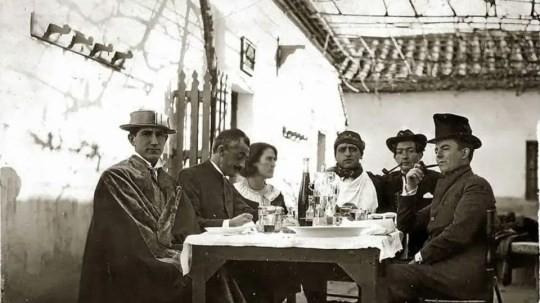
Members of the Order of Toledo, at the Venta de Aires
In Toledo, the members of this order ate, explains Buñuel, "almost always in taverns, such as Venta de Aires, on the outskirts, where we always ordered tortilla on horseback - with pork -, a partridge and white wine from Yepes." . There, in this sale, the friends performed for the first time Don Juan Tenorio, by José Zorrilla, dressed in improvised costumes, where we see that Buñuel is dressed as a parish priest, an irreverence with respect to the church and the double standards of its members that We will always see them reflected in their films. «With regard to this, this relationship between artists and religion, Max Aub told the anecdote that while walking through Toledo they found a Virgin in a niche on the street, it could be the one still located on Alfileritos Street, although it is not documented, that Dalí began to pray in a devout and tender manner, but suddenly began spitting at her angrily and insulting her. He went from one thing to another in an incomprehensible way, once again showing off his surrealist thinking," explains Pantoja.
Alberti says that also on the walls of the Venta de Aires, the brothers of the Order had left the mark of their art. «Under the arbor, the patio of our banquet, the main brothers were portrayed in pencil on the whitewash of the wall. Its author, Salvador Dalí, was also among them. Someone told the innkeepers not to whitewash them, that they were worthy works by a famous painter and that they were worth a lot of money. Despite the warning, years later they no longer existed. They had been erased by new owners of the sale," explains the poet. After eating, they returned to Zocodover, always on foot, making "an obligatory stop at the tomb of Cardinal Tavera, sculpted by Berruguete. A few minutes of contemplation in front of the recumbent statue of the cardinal, dead of alabaster, with pale and sunken cheeks, captured by the sculptor one or two hours before the putrefaction began," adds the filmmaker.
Fisticuffs with the cadets of the Military Academy
Upon returning to the old town, the Order even experienced some fights with the cadets of the Toledo Military Infantry Academy, after some of them rudely complimented María Teresa León, an anecdote that she herself tells. «At I don't know what time, just when we were visiting some taverns to balance with so much church, we came face to face with a group of uniformed boys, who turned to me and said: 'Blonde, I would eat you with suit and with everything'. Buñuel rolled up the sleeves of his shirt and when he saw him advance, the boys ran out so as not to commit themselves to Aragon, a region where the insults are harsher. They caught up with them and, after several punches, the cadets were defeated. A neighbor handed us a jug: 'Drink, drink. These cadets always making a fuss!' Meanwhile, she licked her lips with pleasure because the civilians had beaten the military, those boys are always on the hunt for Toledoan girls," León said.

Rafael Alberti and María Teresa León, poets of the Generation of '27 and members of the Order of Toledo
A confrontation with the military that Buñuel also remembers, although in a somewhat less refined way than the poet. The film director explains in his memoirs. «The cadets were really scary. One day we came across two of them and grabbing María Teresa, Alberti's wife, by the arm, they told her: 'How horny you are.' She protests, offended, I go to her defense and knock down the cadets with my fists. Pierre Unik comes to my aid and kicks one of them. There were seven of us and the two of them, we did not boast. We leave and two civil guards who had seen the fight from afar approach, instead of reprimanding us, they advise us to leave Toledo as soon as possible, to avoid the revenge of the cadets. We don't pay attention to them, and for once, nothing happens».
The Order of Toledo in Tristana
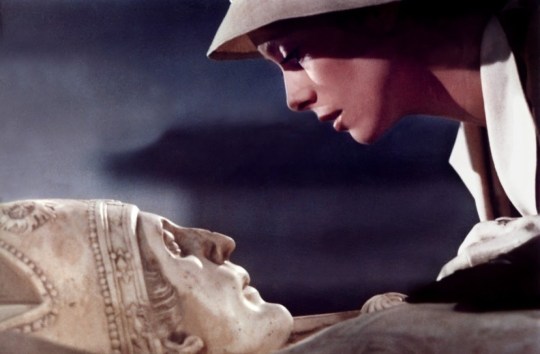
This entire Order of Toledo is reflected in Tristana, the film that Buñuel would shoot here in Toledo. Pantoja defends that "he winked at his youthful adventures, with Catherine Deneuve wandering the streets and visiting Cardinal Tavera, and bringing his face closer to him, which is one of the great images of the film." «That Order of Toledo laughed at everything, nothing was taken too seriously. They laughed at art, like the futurists did, who advocated burning museums and libraries, and they did everything, in addition, in a groundbreaking way. Their lives, without a doubt, were pure avant-garde," concludes Pantoja.
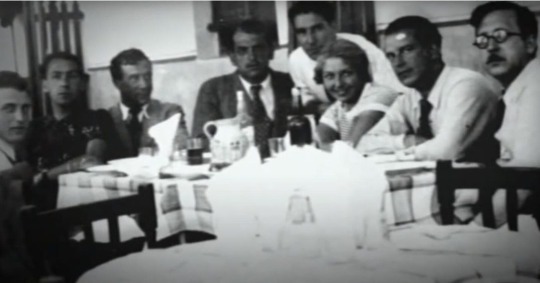
* I have scans of this book, I am planning to publish them here on Tumblr on a series of posts
#la orden de toledo#caballeros de la orden de toledo#knights of the order of toledo#federico garcía lorca#luis buñuel#salvador dalí#order of toledo#maría teresa león#rafael alberti#pepín bello#josé moreno villa
2 notes
·
View notes
Quote
To José Bello Paris, 17 February 1929 ATTENTION! Everything underlined in red is worth ruminating after an initial careful read-through. Dearest Pepín, I got your laconic letter asking me to tell you what topics to write on in your article for L’Amic de les Arts. I’ve already said we very much enjoyed the list of the things you are interested in, and that Dalí was going to send it to L’Amic. I told him to cut out a couple of things, like the one about the Holy Christ’s arses, not because it was in bad taste, because it seemed in excellent taste to me (bearing in mind those aforementioned arses are the only ones you can take out to play without them running off and getting run over by a tram), but rather because the censors might have stepped in and given you a hard time. I think that is precisely the kind of work you should be doing, confident that you will do great things. When you write, rid yourself of all prejudice, forget what people think is literary or in good taste, or idiotic, etc., and give free rein to your instinct. Of course, there will be days when you do nothing, but one day you’ll be inspired, your irrationality will break free, and that’s when great things will happen, you’ll see. Then it’s just a question of a few stylistic revisions (which are very easy), eliminating anything superfluous and leaving just the essential. Never set out to write about something specific, just take up your pen and paper and allow your hand to write freely. Also, never, ever, contemplate writing to a preconceived plot. That’s enough advice for now. I’m sure when we’re together again I’ll be much more help. I’m also sure you will produce great things. You have always been a surrealist and only a surrealist at heart, which is already enough, because surrealism IS THE ONLY INTERESTING THING IN ARTISTIC(?) CREATION. I’ll translate some Benjamín Péret for you below; he’s Dalí’s and my idol, the best poet of our age, maybe of all ages. I’ll also put in one of Dalí’s recent essays and, finally, an extract from a very long and magnificent story I wrote a while ago and that will be included in the book. I’m sure you will love it: it’s infinitely better and more ambitious than our Hamlet. BENJAMIN PERET: I’m writing a supplement on him (with examples) for La Gaceta, which you, Dalí and I will sign. Péret is the big thing in surrealism. If you were here with us, you’d really love reading him. What I’m putting in here for you is just a pale reflection. Bear in mind the difference between the surreal and the simply idiotic that does, however, have some of the same inclinations. Surrealism animates day-to-day reality with all kinds of dark symbols and the strange life in the depths of our subconscious that intelligence, good taste and all that traditional poetic shit has suppressed altogether. That’s why it’s so alive, so close to the primal life-source, to the savage and the child. It is authentic reality, without a posteriori deformation. When we say that Menjou’s moustache does this or that, we are saying more than when we look at the latest torpedo and talk about how fast it can go. For that, you need culture and experience. And honestly, Menjou’s moustache is faster than 50-horse power. We must fight, with our scorn and our rage, all traditional poetry from Homer to Goethe via Góngora – the foulest creature ever born – to the ruinous little turds produced by today’s poets. I’m sorry these suggestions are so unhelpful and so badly expressed, but I’ll make up for them when we’re together. I’m too lazy now to write out the extract from my story. Anyway, I’d prefer you read the whole thing together. The book will be out in about three weeks and I’ll send you a copy at once. You’ll see, modesty aside (and modesty is beside the point anyway, because I only wrote down what I saw), that it’s wonderful. It’s about a soirée at my house that ends in disaster. I’m compelled to visit a wise friend, where strange things happen. From there I end up in hospital on the outskirts of Toledo, where other things happen. In the end I die, not before making my last testament – and what a testament, as you will see – and finally… ‘It was barely said and done in time for me to expire decorously. Four pallbearers took my body and carried it to the church next door to be buried. They lifted the pestilent lid of Cardinal Tavera’s tomb and, taking out his carrion corpse and throwing it on a dung heap as even the poor no longer cared for it, they placed me in there for all eternity. MAY ALL THE LOINCLOTHS REST IN PEACE!!!’ It ends on this line, which is also the title. You should have seen the state the carrion corpse of the Cardinal was in as even the poor no longer cared for it. You’ll piss yourself laughing at everything that goes on with me and the priests, as much as I pissed myself writing it. The poem I sent you in my last letter was based on some lines from this story. By the way, in your last letter you said I hadn’t written for ages. Mine must have crossed yours in the post. You will appreciate the distance that separates you, me and Dalí from all of our poet friends. Incompatible worlds, the north pole of Earth and south pole of Mars, and they are all in the most rancid crater of putrefacción, with no exceptions. Federico wants to write surrealism, but it’s fake, written with intelligence, WHICH IS INCAPABLE OF DISCOVERING WHAT INSTINCT DISCOVERS. The latest excerpt published in La Gaceta shows just how bad. It’s just as artistic as his ‘Ode to the Most Holy Sacrament’, a fetid ode to stiffen the weak pricks of Falla and his artistic kind. Although, when it comes to the irremediably traditional, Federico is one of the best if not the best of them. Alberti disturbs me even more than the idea God exists; than the thought of faeces flowing in the bellies of pretty women; than the Society of Conferences and Courses; the Aragonese jota, concerts by the Symphony Orchestra, than Aladrén; I find Alberti repulsive through and through. The poor thing is trying to make fools of us. If only he could. Alberti, anti-vital and garrulous Alberti. Piu piu currucutupiu tiu tiu tiu. Our film gets stuck into all of this. Moves in the same world. I begin next month. That’s it. Much love from, Buñuel PS Write something and send it to me.
Jo Evans & Breixo Viejo, Luis Buñuel: A Life in Letters
#jo evans#breixo viejo#luis bunuel: a life in letters#luis bunuel#jose bello#salvador dali#benjamin peret#adolphe menjou#rafael alberti
1 note
·
View note
Text
May I add the group of Las Sinsombrero:
• Maria Zambrano (1904- 1991)
• Rosa Chacel ( 1898-1994)
• Margarita Manso ( 1908 -1960)
• Maruja Mallo (1902- 1995)
• Josefina de la Torre (1907−2002)
• Maria Teresa León (1903-1988)
• Concepción Méndez Cuesta ( 1898- 1986)
• Luisa Carnés (1905 - 1964)
• Rosario de Velasco (1904- 1991)
• Marga Gil Roësset (1908 - 1932)
• Delhy Tejero (1904 –1968)
• Remedios Varo (1908 – 1963),
• Ángeles Santos (1911- 2013)
Generation of 27
The Generation of ‘27 (Spanish: Generación del 27) was an influential group of poets that arose in Spanish literary circles between 1923 and 1927, essentially out of a shared desire to experience and work with avant-garde forms of art and poetry. Their first formal meeting took place in Seville in 1927 to mark the 300th anniversary of the death of the baroque poet Luis de Góngora. Writers and intellectuals paid homage at the Ateneo de Sevilla, which retrospectively became the foundational act of the movement.
Terminology:
The Generation of ‘27 has also been called, with lesser success, “Generation of the Dictatorship”, “Generation of the Republic”, “Generation Guillén-Lorca” (Guillén being its oldest author and Lorca its youngest), “Generation of 1925” (average publishing date of the first book of each author), “Generation of Avant-Gardes”, “Generation of Friendship”, etc. According to Petersen, “generation group” or a “constellation” are better terms which are not so much historically restricted as “generation”.
Aesthetic style:
The Generation of '27 cannot be neatly categorized stylistically because of the wide variety of genres and styles cultivated by its members. Some members, such as Jorge Guillén, wrote in a style that has been loosely called jubilant and joyous and celebrated the instant, others, such as Rafael Alberti, underwent a poetic evolution that led him from youthful poetry of a more romantic vein to later politically-engaged verses.
The group tried to bridge the gap between Spanish popular culture and folklore, classical literary tradition and European avant-gardes. It evolved from pure poetry, which emphasized music in poetry, in the vein of Baudelaire, to Futurism, Cubism, Ultraistand Creationism, to become influenced by Surrealism and finally to disperse in interior and exterior exile following the Civil Warand World War II, which are sometimes gathered by historians under the term of the “European Civil War”. The Generation of '27 made a frequent use of visionary images, free verses and the so-called impure poetry, supported by Pablo Neruda.
Members:
In a restrictive sense, the Generation of '27 refers to ten authors, Jorge Guillén, Pedro Salinas, Rafael Alberti, Federico García Lorca, Dámaso Alonso, Gerardo Diego, Luis Cernuda, Vicente Aleixandre, Manuel Altolaguirre and Emilio Prados. However, many others were in their orbit, some older authors such as Fernando Villalón, José Moreno Villa or León Felipe, and other younger authors such as Miguel Hernández. Others have been forgotten by the critics, such as Juan Larrea, Pepe Alameda, Mauricio Bacarisse, Juan José Domenchina, José María Hinojosa, José Bergamín or Juan Gil-Albert. There is also the “Other generation of '27”, a term coined by José López Rubio, formed by himself and humorist disciples of Ramón Gómez de la Serna, including: Enrique Jardiel Poncela, Edgar Neville, Miguel Mihura and Antonio de Lara, “Tono”, writers who would integrate after the Civil War (1936–39) the editing board of La Codorniz.
Furthermore, the Generation of '27, as clearly reflected in the literary press of the period, was not exclusively restricted to poets, including artists such as Luis Buñuel, the caricaturist K-Hito, the surrealist painters Salvador Dalí and Óscar Domínguez, the painter and sculptor Maruja Mallo, as well as Benjamín Palencia, Gregorio Prieto, Manuel Ángeles Ortiz and Gabriel García Maroto, the toreros Ignacio Sánchez Mejías and Jesús Bal y Gay, musicologists and composers belonging to the Group of Eight, including Bal y Gay, Ernesto Halffter and his brother Rodolfo Halffter, Juan José Mantecón, Julián Bautista, Fernando Remacha, Rosa García Ascot, Salvador Bacarisse and Gustavo Pittaluga. There was also the Catalan Group who presented themselves in 1931 under the name of Grupo de Artistas Catalanes Independientes, including Roberto Gerhard, Baltasar Samper, Manuel Blancafort, Ricard Lamote de Grignon, Eduardo Toldrá and Federico Mompou.
Finally, not all literary works were written in Spanish: Salvador Dalí and Óscar Domínguez also wrote in French. Foreigners such as the Chilean poets Pablo Neruda and Vicente Huidobro, the Argentine writer Jorge Luis Borges, and the Franco-Spanish painter Francis Picabia also shared much with the aesthetics of the Generation of '27.
The Generation of '27 was not exclusively located in Madrid, but rather deployed itself in a geographical constellation which maintained links together. The most important nuclei were in Sevilla, around the Mediodía review, Tenerife around the Gaceta de Arte, and Málaga around the Litoral review. Others members resided in Galicia, Catalonia and Valladolid.
The Tendencies of '27:
The name “Generation of 1927” identifies poets that emerged around 1927, the 300th anniversary of the death of the Baroque poet Luis de Góngora y Argote to whom the poets paid homage. It sparked a brief flash of neo-Gongorism by outstanding poets like Rafael Alberti, Vicente Aleixandre, Dámaso Alonso, Luis Cernuda, Gerardo Diego and Federico García Lorca.
Spanish Civil War aftermath:
The Spanish Civil War ended the movement: García Lorca was murdered, Miguel Hernandez died in jail and other writers (Rafael Alberti, Jose Bergamin, León Felipe, Luis Cernuda, Pedro Salinas, Juan Ramón Jiménez, Bacarisse) were forced into exile, although virtually all kept writing and publishing late throughout the 20th century.
Dámaso Alonso and Gerardo Diego were among those who reluctantly remained in Spain after the Francoists won and more or less reached agreements with the new authoritarian and traditionalist regime or even openly supported it, in the case of Diego. They evolved a lot, combining tradition and avant-garde, and mixing many different themes, from toreo to music to religious and existentialist disquiets, landscapes, etc. Others, such as Vicente Aleixandre and Juan Gil-Albert, simply ignored the new regime, taking the path of interior exile and guiding a new generation of poets.
However, for many Spaniards the harsh reality of Francoist Spain and its reactionary nature meant that the cerebral and aesthetic verses of the Generation of '27 did not connect with what was truly happening, a task that was handled more capably by the poets of the Generation of '50 and the social poets.
Statue:
A statue dedicated to the Generation 27 Poets is now in Seville in Spain. The inscription on the monument translates as 'Seville The poets of the Generation of 27’
List of members[edit]
Rafael Alberti (1902–1999)
Vicente Aleixandre (1898–1984)
Amado Alonso (1897–1952)
Dámaso Alonso (1898–1990)
Manuel Altolaguirre (1905–1959)
Francisco Ayala (1906–2009)
Mauricio Bacarisse (1895–1931)
José Bello (1904–2008)
Rogelio Buendía (1891–1969)
Alejandro Casona (1903–1965)
Juan Cazador (1899–1956)
Luis Cernuda (1902–1963)
Juan Chabás (1900–1954)
Ernestina de Champourcín (1905–1999)
Gerardo Diego (1896–1987)
Juan José Domenchina (1898–1959)
Antonio Espina (1894–1972)
Agustín Espinosa (1897–1939)
León Felipe (1884–1968)
Agustín de Foxá (1903–1959)
Pedro García Cabrera (1905–1981)
Federico García Lorca (1898–1936)
Pedro Garfias (1901–1967)
Juan Gil-Albert (1904–1994)
Ernesto Giménez Caballero (1899–1988)
Jorge Guillén (1893–1984)
Emeterio Gutiérrez Albelo (1905–1937)
Miguel Hernández (1910–1942)
José María Hinojosa (1904–1936)
Enrique Jardiel Poncela (1901–1952)
Rafael Laffón (1895–1978)
Antonio de Lara (1896–1978)
Juan Larrea (1895–1980)
José López Rubio (1903–1996)
José María Luelmo (1904–1991)
Francisco Madrid (1900–1952)
Paulino Masip (1899–1963)
Concha Méndez (1898–1986)
Miguel Mihura (1905–1977)
Edgar Neville (1899–1967)
Antonio Oliver (1903–1968)
Pedro Pérez-Clotet (1902–1966)
Rafael Porlán (1899–1945)
Emilio Prados (1899–1962)
Joaquín Romero Murube (1904–1969)
Pedro Salinas (1891–1951)
Guillermo de Torre (1900–1971)
José María Souvirón (1904–1973)
Miguel Valdivieso (1897–1966)
Fernando Villalón (1881–1930)
#g27#generación del 27#federico garcía lorca#luis buñuel#salvador dalí#pepín bello#rafael alberti#dámaso alonso#ernestina de champourcín#among others#las sinsombrero#margarita manso#rosa chacel#maria zambrano#maruja mallo#josefina de la torre
13 notes
·
View notes
Text

"No recuerdo la primera vez que vi el mar. Recuerdo, sin embargo, la primera vez que mi padre me leyó en voz alta la canción del pirata de Espronceda. Ese día entré en el relato, me convertí en un habitante de las palabras, reconocí mi rebeldía en la libertad de un personaje que navegaba sin miedo por el mundo. No se trata de que para mí sean más importantes los libros que la vida, lo que ocurre, es que no entiendo la vida sin los libros, que se vive tanto en una plaza o en una calle como en un poema. Conmigo van las mañanas de colegio en las que descubrí a Antonio Machado, la infinita melancolía de la adolescencia en la huerta de San Vicente con Federico García Lorca, los primeros años en la Universidad, la luz de Cádiz compartida con Rafael Alberti; vivir, convivir, celebrar lo que se tiene, recordar lo que se ha perdido. Da rabia que nunca haya tiempo para las cosas importantes, para hacer posible esa conversación que nos devuelve a la verdad de nosotros mismos. Los poetas trabajan su soledad y piensan en todo, piensan en ti, aunque tú no lo sepas".
Luis García Montero
13 notes
·
View notes
Text
"No recuerdo la primera vez que vi el mar. Recuerdo, sin embargo, la primera vez que mi padre me leyó en voz alta la canción del pirata de Espronceda. Ese día entré en el relato, me convertí en un habitante de las palabras, reconocí mi rebeldía en la libertad de un personaje que navegaba sin miedo por el mundo. No se trata de que para mí sean más importantes los libros que la vida, lo que ocurre, es que no entiendo la vida sin los libros, que se vive tanto en una plaza o en una calle como en un poema. Conmigo van las mañanas de colegio en las que descubrí a Antonio Machado, la infinita melancolía de la adolescencia en la huerta de San Vicente con Federico García Lorca, los primeros años en la Universidad, la luz de Cádiz compartida con Rafael Alberti; vivir, convivir, celebrar lo que se tiene, recordar lo que se ha perdido. Da rabia que nunca haya tiempo para las cosas importantes, para hacer posible esa conversación que nos devuelve a la verdad de nosotros mismos. Los poetas trabajan su soledad y piensan en todo, piensan en ti, aunque tú no lo sepas".
—Luis García Montero
5 notes
·
View notes
Photo
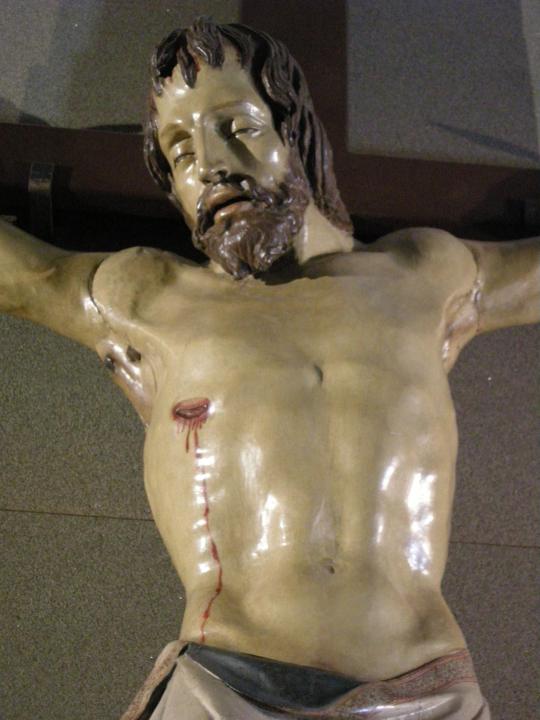
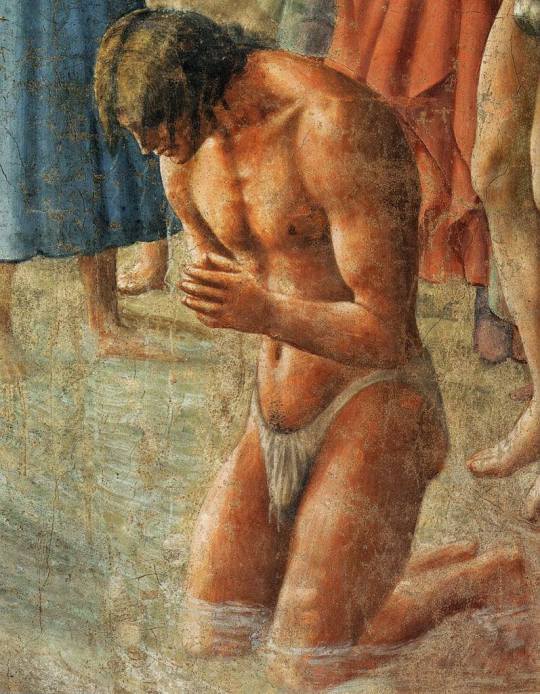
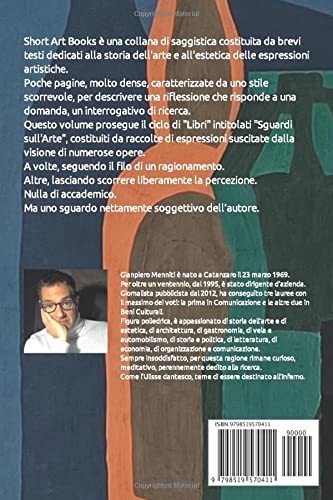
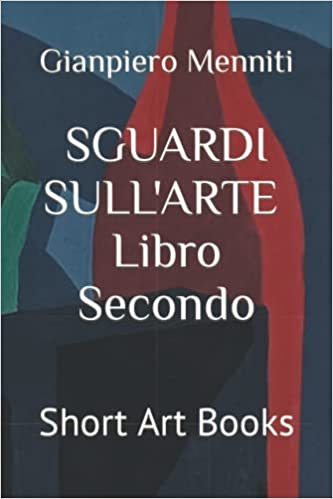
Da: SGUARDI SULL’ARTE LIBRO SECONDO - di Gianpiero Menniti
INCROCI POETICI
Donatello non riconosce una dimensione diversa ai santi, alle figure religiose, rispetto alla sensibilità umana. Tuttavia, ne accresce la potenza interiore, la dominante esaltazione di un senso di forza che ha una radice immateriale, impalpabile eppure visibile nell’atto espressivo colto in un istante assoluto. La forza dell’arte è esattamente questa: cogliere l’istante irripetibile come sintesi materiale del tumulto inspiegabile dell’animo, di un animo inquieto sempre in bilico tra incertezza terrena ed aspirazione ideale, tra il dubbio giacente ed il dubbio fugato, tra verità ed apparenza. Donatello è un moderno. In lui è chiara la vacuità dell’armamentario gotico, accetta l’equilibrio delle forme come espressione razionale dell’umano (in questo mostrandosi vicino a Brunelleschi), ma non è disposto a vedere l’uomo alla stregua di una costruzione architettonica perfetta: nell’uomo, la forma è condizionata dallo spirito e questo può essere colto solo a patto di allontanarsi da forme ideali, scegliendo il vero al verosimile. Il vero materiale ed il vero dell’anima. Così, emerge la relazione con la poetica di Masaccio. E sulla scia di quella concezione, c’è anche la preminenza di un’idea rinascimentale che diverge sia dai temi cari a Brunelleschi che dalla visione aulica e vagamente retorica del primo Leon Battista Alberti: Donatello e Masaccio, sono stati i primi artisti ad aver intuito le radici tragiche in cui affonda l'Umanesimo.
- Donatello (1386 - 1466): "Crocifisso" (Basilica di Santa Croce, Firenze), 1406 -1408, particolare
- Masaccio (1401 - 1428): "Il battesimo dei neofiti" (Cappella Brancacci, chiesa di Santa Maria del Carmine, Firenze), 1424 - 1426, particolare
- In copertina: Maria Casalanguida, "Bottiglie e cubetto", 1975, collezione privata
8 notes
·
View notes
Text
Netflixable? Mexican Commandos fend of the "Dogs" of a Cartel -- "Counterattack (Counterstrike, Contraataque)"
An elite Mexican commando unit battling cartels and corruption must shoot and fight its way north — to safety in Brownsville — in the chest-thumping shoot-em-up “Counterattack.” Nothing is made of that irony, and that’s just one of many loose threads in this loose cannon B-movie from South of the Border. Luis Alberti is Captain Guerrero, who finishes up an afternoon of drinking and gambling…

View On WordPress
0 notes
Text
Counterstrike (2025)
When a hostage rescue mission creates a new enemy, Capt. Guerrero and his elite soldiers must face an ambush by a ruthless drug cartel. Type: movie Release Date: Feb 28, 2025 Country: Mexico Language: Spanish Genre: Action, Adventure, Thriller Cast: Mayra Batalla as Lucía Noé Hernández as Josefo “El Aguijón” Urías Luis Alberti as Capitán Guerrero David Calderón as Combo Leonardo Alonso as Tanque…
0 notes
Photo

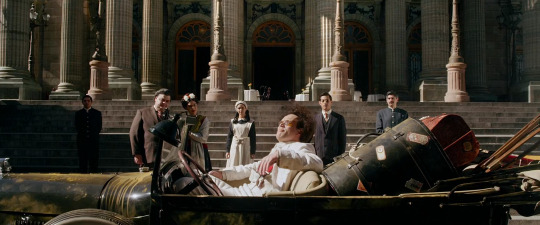
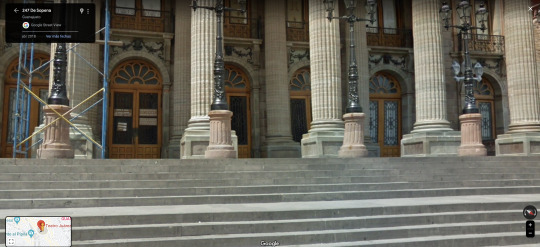

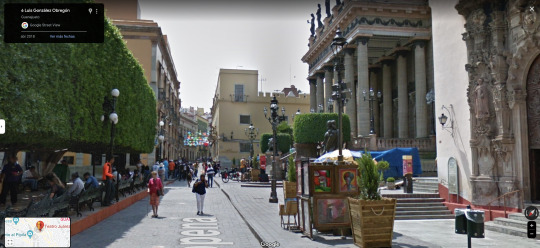
Eisenstein in Guanajuato Peter Greenaway. 2015
Hotel De Sopena 10, Centro, 36000 Guanajuato, Gto., Mexico See in map
See in imdb
#peter greenaway#eisenstein in guanajuato#elmer bäck#luis alberti#lisa owen#guanajuato#mexico#teatro juarez#movie#cinema#film#location#google maps#street view#serguéi eisenstein#2015
9 notes
·
View notes
Text
Counterattack (2025) Movie Review
Counterattack is an intense military movie about five friends attacked by a sicario hit squad seeking revenge for a gang member.
Counterattack – Movie Review First Reaction – Counterattack is an intense movie. Watch Counterattack on Netflix now. Director: Chava Cartas Writer: Jose Ruben Escalante Mendez (Screenplay) Cast Noe Hernandez (Parvulos) Luis Alberti Mayra Batalla (Huesera) Roberta Burns (Rumba Love) Alejandra Herrera Plot: Five friends shopping at US/Mexico border face sicario hitmen, but the targets…
0 notes
Text
Holidays 2.18
Holidays
Armed Forces Day (Sierra Leone)
Clean Out Your Cubby Holes Day
Cold Day in Hell
Critical Care Transport Nurses Day
Dale Earnhardt Remembrance Day
Day of Diplomatic Staff (Turkmenistan)
Day of Spenta Armaiti (Zoroastrian Goddess of Earth & Fertility)
Dialect Day (Amami Islands, Japan)
Don Luis Muñoz-Marín Day (Puerto Rico)
Enzo Ferrari Day
Flirting Day
Hertha Asteroid Day
Huck Finn Day
International Asperger’s Day
International Worldbuilding Day
Island Languages Day (Amami Islands)
Kimathi Day (Kenya)
King Biscuit Flower Hour Day
Konudagur (Wife’s Day; Iceland) [1st Day of Góa]
Kurdish Students Union Day (Iraqi Kurdistan)
National Airboat Day
National Battery Day
National Democracy Day (Overthrow of Rana Dynasty; Nepal)
National Hate Florida Day
National Thumb Appreciation Day
Pluto Discovery Day
Rain Water Day (Chinese Farmer’s Calendar)
Rakali Awareness Day
Saidai-ji Eyo Hadaka Matsuri (Naked Festival; Japan)
Sleigh Day (French Republic)
Stained Glass Appreciation Day
Tacita (a.k.a. Rites of Tacita; Roman Silent Goddess)
Tanigumi Odori (Dance Festival; Japan)
Toni Morrison Day (Ohio)
Thumb Appreciation Day
218 Day
University Mental Health and Well-Being Day (UK)
World Corporate Social Responsibility Day
World Information Architecture Day
Food & Drink Celebrations
Drink Wine Day
Eat Ice Cream for Breakfast Day
National Crab-Stuffed Flounder Day
Nature Celebrations
Buttercup (Innocent; Korean Birth Flowers)
Cow Milked While Flying in an Airplane Day
Independence, Flag & Related Days
Democracy Day (Nepal)
The Gambia (from UK, 1965)
Manchurian Independence Day
Roscamistan (Declared; 2021) [unrecognized]
3rd Tuesday in February
Taco Tuesday [Every Tuesday]
Tapas Tuesday [3rd Tuesday of Each Month]
Target Tuesday [Every Tuesday]
Tater Tot Tuesday [Every Tuesday]
Travel Africa Day [3rd Tuesday]
Trivia Tuesday [Every Tuesday]
Trusting Tuesday [3rd Tuesday of Each Month]
Two For Tuesday [Every Tuesday]
Weekly Holidays beginning February 18 (3rd Week of February)
American Campy Week (thru 2.21)
Festivals On or Beginning February 18, 2025
Smooth Jazz Cruise Fort Lauderdale, Florida) [thru 2.25]
Weekly Holidays beginning February 18
Aromatic Spectrum Awareness Week [thru 2.24]
Bird Health Awareness Week [thru 2.24]
Brotherhood / Sisterhood Week [thru 2.24]
Build a Better Trade Show Image Week [thru 2.24]
Engineers Week begins [thru 2.24]
National Justice for Animals Week [thru 2.24]
National Sauna Week [thru 2.24]
Through with the Chew Week (Chewing Tobacco) [thru 2.24]
Feast Days
Angilbert (Christian; Saint)
Aristophanes (Positivist; Saint)
Awen: The Three Drops of Inspiration (Celtic Book of Days)
Bernadette Soubirous (Lourdes, France; Christian; Saint) [also 4.16]
The Blue-Breasted Party Pigeon (Muppetism)
Colmán of Lindisfarne (Christian; Saint)
Festival of Women (Ancient Persia)
Flavian of Constantinople (Christian; Saint)
Fly-By for Faeries and Elves (Shamanism)
The Fornicalia (a.k.a. The Feral; to the God Manes; Ancient Rome)
Fra Angelico (Christian; Saint)
Frank Miller Day (Church of the SubGenius; Saint)
Geltrude Comensoli (Christian; Saint)
Helladius of Toledo (Christian; Saint)
Ishtar’s Day (Pagan)
Ivrea Carnival begins (Ivrea, Italy) [Saturday before Lent; thru Monday]
Leo and Paragorius (Christian; Martyrs)
Navel Appreciation Day (Pastafarian)
Rites of Tacita (Goddess of Silence; Ancient Rome)
Sepandārmazgān (Women's Day; Zoroastrian Iran)
Simeon of Jerusalem (a.k.a. Simon; Western Christianity)
Spenta Armaiti (Festival of Women; Zoroastrian)
Theotonius (Christian; Saint)
Lunar Calendar Holidays
Chinese: Month 1 (Wu-Yin), Day 21 (Wu-Wu)
Day Pillar: Earth Horse
12-Day Officers/12 Gods: Stable Day (定 Ding) [Auspicious]
Holidays: None Known
Secular Saints Days
Jean M. Auel (Literature)
Carrie Ann Baade (Art)
Leone Battista Alberti (Art)
Wallace Berman (Art)
Andre Breton (Literature)
Michelangelo Cerquozzi (Art)
Len Deighton (Literature)
Milos Forman (Entertainment)
William Laurel Harris (Art)
Johnny Hart (Art)
John Hughes (Entertainment)
Nikos Kazantzakis (Literature)
Max Klinger (Art)
Henri Laurens (Art)
Henri Leys (Art)
Luis Muñoz Marín (Politics)
Duane Michaels (Art)
Toni Morrison (Literature)
Jack Palance (Entertainment)
Molly Ringwald (Entertainment)
Wallace Stegner (Literature)
Louise Comfort Tiffany (Art)
John Travolta (Entertainment)
Alessandro Volta (Science)
Gahan Wilson (Art)
Dennis de Young (Music)
Anders Zorn (Art)
Lucky & Unlucky Days
Perilous Day (13th Century England) [10 of 32]
Sakimake (先負 Japan) [Bad luck in the morning, good luck in the afternoon.]
Tycho Brahe Unlucky Day (Scandinavia) [10 of 37]
Unglückstage (Unlucky Day; Pennsylvania Dutch) [10 of 30]
Premieres
The Big Broadcast of 1938 (Film; 1938)
The Big Rock Candy Mountain, by Wallace Stegner (Novel; 1943)
Bringing Up Baby (Film; 1938)
Constantine (Film; 2005)
The Cuphead Show! (Animated TV Series; 2022)
A German Requiem, by Johannes Brahms (Requiem; 1869)
Good Vibrations, recorded by Brian Wilson and The Beach Boys (Song; 1966)
The Henpecked Rooster (Noveltoons Cartoon; 1944)
The High and the Flighty (WB MM Cartoon; 1956)
The House of Seven Gargoyles (Animated TV Show;Jonny Quest #23; 1965)
I Am Number Four (Film; 2011)
The Invincible, by Stanisław Lem (Novel; 1964)
Just Ask Jupiter (Terrytoons Cartoon; 1938)
The King of Comedy (Film; 1983)
Kiss, by Kiss (Album; 1974)
Kitbull (SparkShorts Pixar Cartoon; 1933)
Lake Titicaca (Disney Cartoon; 1955)
Learn Politeness (Fleischer Popeye Cartoon; 1938)
The Lion’s Busy (WB LT Cartoon; 1950)
Local Hero (Film; 1983)
Mickey’s Pal Pluto (Pluto Disney Cartoon; 1933)
Mickey’s Surprise Party (Mickey Mouse Disney Cartoon; 1939)
The Missing Mustache or Hair Today, Gone Tomorrow (Rocky & Bullwinkle Cartoon, S5, Ep. 258; 1964)
No Jacket Required, by Phil Collins (Album; 1985)
Mister Roberts, by Thomas Hegel and Joshua Logan (Play; 1948)
Pilgrim’s Progress, by John Bunyan (Novel; 1678)
The Pirates of Penzance (Film; 1983)
Porky’s Tire Trouble (WB LT Cartoon; 1939)
Reality Bites (Film; 1994)
The Richest Man in Babylon, by George S. Clason (Book; 1926)
Rumble (Animated Film; 2022)
Samson, by George Frideric Handel (Oratorio; 1743)
Schultze Gets the Blues (Film; 2005)
Severance (TV Series; 2022)
Sick Cylinders (Oswald the Lucky Rabbit Cartoon; 1929)
Trombone Trouble (Disney Cartoon; 1944)
Uncharted (Film; 2022)
The Villain’s Victory Dance or The Jig is Up (Rocky & Bullwinkle Cartoon, S5, Ep. 257; 1964)
What’d I Say, recorded by Ray Charles (Song; 1959)
The Whole Nine Yards (Film; 2000)
Zorba the Greek, by Nikos Kazantzakis (Novel; 1946)
Today’s Name Days
Constanze, Simon, Simone (Austria)
Bernarda, Šimun (Croatia)
Gisela (Czech Republic)
Concordia (Denmark)
Karita, Karme, Karmen, Rita (Estonia)
Kaino (Finland)
Bernadette (France)
Constanza, Simon, Simone (Germany)
Agapitos, Leon (Greece)
Bernadett (Hungary)
Cinzia, Claudio, Simeone (Italy)
Indra, Kintija, Konkordija, Kora, Vizma (Latvia)
Bernadeta, Gendrė, Lengvenis, Simeonas (Lithuania)
Frode, Frøydis (Norway)
Albert, Alberta, Albertyna, Fryda, Konstancja, Krystiana, Maksym, Sawa, Sylwan, Sylwana, Symeon, Więcesława, Zula, Zuzanna (Poland)
Leon (Romania)
Jaromír (Slovakia)
Eladio, Heladio (Spain)
Frida, Fritiof (Sweden)
Bentley, Blythe, Flavia, Flavian (USA)
Today’s National Name Days
National Duane Day
National Toni Day
Today is Also…
Day of Year: Day 49 of 2025; 316 days remaining in the year
ISO Week: Day 2 of Week 8 of 2025
Celtic Tree Calendar: Nuin (Ash) [Day 21 of 28]
Chinese: Month 1 (Wu-Yin), Day 21 (Wu-Wu)
Chinese Year of the: Snake 4723 (until February 17, 2026) [Ding-Chou]
Coptic: 11 Amshir 1741
Druid Tree Calendar: Hackberry (Feb 9-18) [Day 10 of 10]
Hebrew: 20 Shevat 5785
Islamic: 19 Sha’ban 1446
Julian: 5 February 2025
Moon: 69%: Waning Gibbous
Positivist: 21 Homer (2nd Month) [Aristophanes)
Runic Half Month: Sigel (Sun) [Day 13 of 15]
Season: Winter (Day 60 of 90)
SUn Calendar: 19 Gray; Fryday [19 of 30]
Week: 3rd Week of February
Zodiac:
Tropical (Typical) Zodiac: Aquarius (Day 30 of 30)
Sidereal Zodiac: Aquarius (Day 6 of 30)
Schmidt Zodiac: Capricorn (Day 24 of 27)
IAU Boundaries (Current) Zodiac: Aquarius (Day 2 of 23)
IAU Boundaries (1977) Zodiac: Aquarius (Day 3 of 24)
Calendar Changes
Nuin (Ash) [Celtic Tree Calendar; Month 2 of 13]
0 notes
Text
Holidays 2.18
Holidays
Armed Forces Day (Sierra Leone)
Clean Out Your Cubby Holes Day
Cold Day in Hell
Critical Care Transport Nurses Day
Dale Earnhardt Remembrance Day
Day of Diplomatic Staff (Turkmenistan)
Day of Spenta Armaiti (Zoroastrian Goddess of Earth & Fertility)
Dialect Day (Amami Islands, Japan)
Don Luis Muñoz-Marín Day (Puerto Rico)
Enzo Ferrari Day
Flirting Day
Hertha Asteroid Day
Huck Finn Day
International Asperger’s Day
International Worldbuilding Day
Island Languages Day (Amami Islands)
Kimathi Day (Kenya)
King Biscuit Flower Hour Day
Konudagur (Wife’s Day; Iceland) [1st Day of Góa]
Kurdish Students Union Day (Iraqi Kurdistan)
National Airboat Day
National Battery Day
National Democracy Day (Overthrow of Rana Dynasty; Nepal)
National Hate Florida Day
National Thumb Appreciation Day
Pluto Discovery Day
Rain Water Day (Chinese Farmer’s Calendar)
Rakali Awareness Day
Saidai-ji Eyo Hadaka Matsuri (Naked Festival; Japan)
Sleigh Day (French Republic)
Stained Glass Appreciation Day
Tacita (a.k.a. Rites of Tacita; Roman Silent Goddess)
Tanigumi Odori (Dance Festival; Japan)
Toni Morrison Day (Ohio)
Thumb Appreciation Day
218 Day
University Mental Health and Well-Being Day (UK)
World Corporate Social Responsibility Day
World Information Architecture Day
Food & Drink Celebrations
Drink Wine Day
Eat Ice Cream for Breakfast Day
National Crab-Stuffed Flounder Day
Nature Celebrations
Buttercup (Innocent; Korean Birth Flowers)
Cow Milked While Flying in an Airplane Day
Independence, Flag & Related Days
Democracy Day (Nepal)
The Gambia (from UK, 1965)
Manchurian Independence Day
Roscamistan (Declared; 2021) [unrecognized]
3rd Tuesday in February
Taco Tuesday [Every Tuesday]
Tapas Tuesday [3rd Tuesday of Each Month]
Target Tuesday [Every Tuesday]
Tater Tot Tuesday [Every Tuesday]
Travel Africa Day [3rd Tuesday]
Trivia Tuesday [Every Tuesday]
Trusting Tuesday [3rd Tuesday of Each Month]
Two For Tuesday [Every Tuesday]
Weekly Holidays beginning February 18 (3rd Week of February)
American Campy Week (thru 2.21)
Festivals On or Beginning February 18, 2025
Smooth Jazz Cruise Fort Lauderdale, Florida) [thru 2.25]
Weekly Holidays beginning February 18
Aromatic Spectrum Awareness Week [thru 2.24]
Bird Health Awareness Week [thru 2.24]
Brotherhood / Sisterhood Week [thru 2.24]
Build a Better Trade Show Image Week [thru 2.24]
Engineers Week begins [thru 2.24]
National Justice for Animals Week [thru 2.24]
National Sauna Week [thru 2.24]
Through with the Chew Week (Chewing Tobacco) [thru 2.24]
Feast Days
Angilbert (Christian; Saint)
Aristophanes (Positivist; Saint)
Awen: The Three Drops of Inspiration (Celtic Book of Days)
Bernadette Soubirous (Lourdes, France; Christian; Saint) [also 4.16]
The Blue-Breasted Party Pigeon (Muppetism)
Colmán of Lindisfarne (Christian; Saint)
Festival of Women (Ancient Persia)
Flavian of Constantinople (Christian; Saint)
Fly-By for Faeries and Elves (Shamanism)
The Fornicalia (a.k.a. The Feral; to the God Manes; Ancient Rome)
Fra Angelico (Christian; Saint)
Frank Miller Day (Church of the SubGenius; Saint)
Geltrude Comensoli (Christian; Saint)
Helladius of Toledo (Christian; Saint)
Ishtar’s Day (Pagan)
Ivrea Carnival begins (Ivrea, Italy) [Saturday before Lent; thru Monday]
Leo and Paragorius (Christian; Martyrs)
Navel Appreciation Day (Pastafarian)
Rites of Tacita (Goddess of Silence; Ancient Rome)
Sepandārmazgān (Women's Day; Zoroastrian Iran)
Simeon of Jerusalem (a.k.a. Simon; Western Christianity)
Spenta Armaiti (Festival of Women; Zoroastrian)
Theotonius (Christian; Saint)
Lunar Calendar Holidays
Chinese: Month 1 (Wu-Yin), Day 21 (Wu-Wu)
Day Pillar: Earth Horse
12-Day Officers/12 Gods: Stable Day (定 Ding) [Auspicious]
Holidays: None Known
Secular Saints Days
Jean M. Auel (Literature)
Carrie Ann Baade (Art)
Leone Battista Alberti (Art)
Wallace Berman (Art)
Andre Breton (Literature)
Michelangelo Cerquozzi (Art)
Len Deighton (Literature)
Milos Forman (Entertainment)
William Laurel Harris (Art)
Johnny Hart (Art)
John Hughes (Entertainment)
Nikos Kazantzakis (Literature)
Max Klinger (Art)
Henri Laurens (Art)
Henri Leys (Art)
Luis Muñoz Marín (Politics)
Duane Michaels (Art)
Toni Morrison (Literature)
Jack Palance (Entertainment)
Molly Ringwald (Entertainment)
Wallace Stegner (Literature)
Louise Comfort Tiffany (Art)
John Travolta (Entertainment)
Alessandro Volta (Science)
Gahan Wilson (Art)
Dennis de Young (Music)
Anders Zorn (Art)
Lucky & Unlucky Days
Perilous Day (13th Century England) [10 of 32]
Sakimake (先負 Japan) [Bad luck in the morning, good luck in the afternoon.]
Tycho Brahe Unlucky Day (Scandinavia) [10 of 37]
Unglückstage (Unlucky Day; Pennsylvania Dutch) [10 of 30]
Premieres
The Big Broadcast of 1938 (Film; 1938)
The Big Rock Candy Mountain, by Wallace Stegner (Novel; 1943)
Bringing Up Baby (Film; 1938)
Constantine (Film; 2005)
The Cuphead Show! (Animated TV Series; 2022)
A German Requiem, by Johannes Brahms (Requiem; 1869)
Good Vibrations, recorded by Brian Wilson and The Beach Boys (Song; 1966)
The Henpecked Rooster (Noveltoons Cartoon; 1944)
The High and the Flighty (WB MM Cartoon; 1956)
The House of Seven Gargoyles (Animated TV Show;Jonny Quest #23; 1965)
I Am Number Four (Film; 2011)
The Invincible, by Stanisław Lem (Novel; 1964)
Just Ask Jupiter (Terrytoons Cartoon; 1938)
The King of Comedy (Film; 1983)
Kiss, by Kiss (Album; 1974)
Kitbull (SparkShorts Pixar Cartoon; 1933)
Lake Titicaca (Disney Cartoon; 1955)
Learn Politeness (Fleischer Popeye Cartoon; 1938)
The Lion’s Busy (WB LT Cartoon; 1950)
Local Hero (Film; 1983)
Mickey’s Pal Pluto (Pluto Disney Cartoon; 1933)
Mickey’s Surprise Party (Mickey Mouse Disney Cartoon; 1939)
The Missing Mustache or Hair Today, Gone Tomorrow (Rocky & Bullwinkle Cartoon, S5, Ep. 258; 1964)
No Jacket Required, by Phil Collins (Album; 1985)
Mister Roberts, by Thomas Hegel and Joshua Logan (Play; 1948)
Pilgrim’s Progress, by John Bunyan (Novel; 1678)
The Pirates of Penzance (Film; 1983)
Porky’s Tire Trouble (WB LT Cartoon; 1939)
Reality Bites (Film; 1994)
The Richest Man in Babylon, by George S. Clason (Book; 1926)
Rumble (Animated Film; 2022)
Samson, by George Frideric Handel (Oratorio; 1743)
Schultze Gets the Blues (Film; 2005)
Severance (TV Series; 2022)
Sick Cylinders (Oswald the Lucky Rabbit Cartoon; 1929)
Trombone Trouble (Disney Cartoon; 1944)
Uncharted (Film; 2022)
The Villain’s Victory Dance or The Jig is Up (Rocky & Bullwinkle Cartoon, S5, Ep. 257; 1964)
What’d I Say, recorded by Ray Charles (Song; 1959)
The Whole Nine Yards (Film; 2000)
Zorba the Greek, by Nikos Kazantzakis (Novel; 1946)
Today’s Name Days
Constanze, Simon, Simone (Austria)
Bernarda, Šimun (Croatia)
Gisela (Czech Republic)
Concordia (Denmark)
Karita, Karme, Karmen, Rita (Estonia)
Kaino (Finland)
Bernadette (France)
Constanza, Simon, Simone (Germany)
Agapitos, Leon (Greece)
Bernadett (Hungary)
Cinzia, Claudio, Simeone (Italy)
Indra, Kintija, Konkordija, Kora, Vizma (Latvia)
Bernadeta, Gendrė, Lengvenis, Simeonas (Lithuania)
Frode, Frøydis (Norway)
Albert, Alberta, Albertyna, Fryda, Konstancja, Krystiana, Maksym, Sawa, Sylwan, Sylwana, Symeon, Więcesława, Zula, Zuzanna (Poland)
Leon (Romania)
Jaromír (Slovakia)
Eladio, Heladio (Spain)
Frida, Fritiof (Sweden)
Bentley, Blythe, Flavia, Flavian (USA)
Today’s National Name Days
National Duane Day
National Toni Day
Today is Also…
Day of Year: Day 49 of 2025; 316 days remaining in the year
ISO Week: Day 2 of Week 8 of 2025
Celtic Tree Calendar: Nuin (Ash) [Day 21 of 28]
Chinese: Month 1 (Wu-Yin), Day 21 (Wu-Wu)
Chinese Year of the: Snake 4723 (until February 17, 2026) [Ding-Chou]
Coptic: 11 Amshir 1741
Druid Tree Calendar: Hackberry (Feb 9-18) [Day 10 of 10]
Hebrew: 20 Shevat 5785
Islamic: 19 Sha’ban 1446
Julian: 5 February 2025
Moon: 69%: Waning Gibbous
Positivist: 21 Homer (2nd Month) [Aristophanes)
Runic Half Month: Sigel (Sun) [Day 13 of 15]
Season: Winter (Day 60 of 90)
SUn Calendar: 19 Gray; Fryday [19 of 30]
Week: 3rd Week of February
Zodiac:
Tropical (Typical) Zodiac: Aquarius (Day 30 of 30)
Sidereal Zodiac: Aquarius (Day 6 of 30)
Schmidt Zodiac: Capricorn (Day 24 of 27)
IAU Boundaries (Current) Zodiac: Aquarius (Day 2 of 23)
IAU Boundaries (1977) Zodiac: Aquarius (Day 3 of 24)
Calendar Changes
Nuin (Ash) [Celtic Tree Calendar; Month 2 of 13]
1 note
·
View note
Text


Massimiliano Campelli innesca vibrazioni muovendo persona, lì dentro.
A me però interessa anche il Leon Battisti Alberti che c'è dentro lì.
Ed il Raffaello Sanzio, parimenti presente in spirito.
Sapete, a quell'epoca il Gazzettino ed il Pettegolino - peraltro insigne umanista - era Giorgio Vasari.
Secondo lui le tre tavole delle sì appellate Città Ideali potrebbe averle dipinte lui, ma non ne siamo sicuri.
Eccomunque, nella tavola di Urbino quell'edificio centrale pseudeperiptero rimembrami lo pseudobattistero di Raffaello Sanzio.
E, per architetture, La Scuola d'Atene di Raffaello istesso.
Profumo di rinascimentali prospettive, ed insomma.
Stesse atmosfere di Massimiliano, in cornice.
Nello sfondo che fa da cornice, intendo.
Geometriche fughe, tranne che per l'evanescente modella.
Non fugge, lei.
E' testimone di passate vite, lei, dentro lì.
Roberto Brunetti ascende nei secoli.
Mica troppi, epperò.
Perché se anche lì il rigore si sposa alla seduzione, il suo sguardo pittorico prosegue oltre.
Verso il misterioso silenzio di un altro Giorgio rispetto al Vasari, eccioè De Chirico.
E se il primo Giorgio diceva che Leon era maestro di forme senza figure, la figura di Roberto traghetta verso la stuporosa attonicità di Edward Hopper.
Senza dimenticare il giallo caldo pallore - se mi concedete l'ossimoro - di Giovanni Antonio Canal.
Prosciugato, epperò.
Via la gente, rimane un unico soggetto.
Che non è soggetto, bensì attore del generale arazzo.
Reificato, nel generale arazzo.
Anch'egli architettura, e cromatico elemento.
Architettura, non architetto.
Perché l'architetto qui è Roberto.
Architetto Poeta, epperò, al di là dell'apparente emotiva pudicizia.
All rights reserved
Claudio Trezzani
0 notes
Text

Joaquín Sabina, el emblemático cantautor español, es un hombre cuya vida y obra están profundamente marcadas por sus gustos, pasiones y vivencias. Su universo es tan amplio y colorido como sus canciones, llenas de poesía, ironía, nostalgia y una visión única de la vida. A continuación, exploraremos las cosas que más han marcado a Sabina en lo personal y profesional, aquellas que han moldeado su estilo, su personalidad y su arte.
La música como pasión y refugio
Sabina tiene un profundo amor por la música, no solo como creador, sino también como oyente. Admirador de Bob Dylan, Leonard Cohen y The Beatles, encontró en ellos una fuente de inspiración que marcaría su forma de componer. También se declara amante del flamenco, con figuras como Camarón de la Isla y Paco de Lucía, quienes influyeron en su aprecio por lo auténtico y profundo de la música popular española. Además, su relación con colegas como Joan Manuel Serrat, con quien grabó discos y realizó giras, refleja su afinidad por la música de autor y la amistad que surge a través del arte.
Los amigos y la bohemia
Sabina siempre ha sido un hombre de tertulias, de largas conversaciones en bares y cafés, rodeado de amigos con quienes comparte ideas y risas. Su vida bohemia lo llevó a construir relaciones con figuras de la cultura española e internacional, como el poeta Luis García Montero, Gabriel García Márquez, Pablo Neruda, personajes como José Alfredo Jiménez, chavela Vargas, Pablo Milanés, Silvio Rodríguez, Luis Eduardo Aute, Miguel Ríos, Ana Belén, Krahe, Víctor Manuel, el cineasta Fernando León de Aranoa, y músicos como Antonio García de Diego, quienes han sido sus inseparables compañeros de viaje artístico. Sabina valora profundamente la amistad y, aunque se define como un alma libre, siempre encuentra en sus amigos un pilar fundamental en su vida.
Los libros y la poesía
La literatura ha sido uno de los amores más constantes en la vida de Sabina. Desde joven devoró las obras de grandes escritores como Franz Kafka, Charles Bukowski, Julio Cortázar, Mario Benedetti, y Federico García Lorca. La poesía, en particular, ha sido su compañera inseparable, con influencias de Antonio Machado, Rafael Alberti y Jaime Gil de Biedma. Para Sabina, los libros no solo son un refugio, sino también una fuente inagotable de inspiración que nutre su creatividad y su visión del mundo.
La gastronomía y el placer de comer
Aunque Sabina nunca se ha definido como un sibarita, disfruta de la buena comida. Es amante de los sabores tradicionales españoles, especialmente las tapas, el jamón ibérico, las paellas y los platos caseros que evocan la cocina mediterránea. También ha confesado su gusto por los bares, donde el ambiente es tan importante como lo que se sirve. Sabina encuentra en la comida un pretexto para compartir momentos con amigos, hablar de la vida y escribir versos improvisados.
Los lugares y los viajes
Sabina tiene un vínculo especial con Madrid, ciudad que adoptó como su hogar y que aparece frecuentemente en sus canciones. Sin embargo, su espíritu viajero lo llevó a enamorarse de otras ciudades como Buenos Aires, México D.F , Costa Rica, La Habana y Londres, donde vivió durante años. Estas ciudades han dejado huella en su obra, inspirando canciones y versos llenos de nostalgia y admiración. En América Latina encontró una segunda casa, fascinado por la calidez de su gente, la riqueza cultural y la pasión que allí se vive.
Los personajes que admira
Entre los personajes históricos y artísticos que admira, destacan poetas como Pablo Neruda y escritores como Gabriel García Márquez, quienes influyeron en su forma de ver el mundo. También ha expresado admiración por figuras rebeldes como Ernesto "Che" Guevara y Salvador Allende, cuyas luchas por la justicia social resonaron con su espíritu inconformista.
Las pequeñas cosas de la vida
Sabina encuentra belleza en los detalles cotidianos: una conversación sincera, el sonido de la lluvia, la melancolía de una calle vacía, o el bullicio de una taberna. Es un hombre que celebra tanto la grandeza de los momentos épicos como la magia de lo sencillo. Su vida está marcada por un constante juego entre la realidad y la fantasía, siempre con una pizca de humor y una mirada irónica hacia sí mismo y el mundo.
Conclusión
Joaquín Sabina es un alma inquieta, un amante de la vida con todas sus contradicciones. Sus gustos reflejan a un hombre que ha vivido intensamente, que ha amado, perdido, reído y llorado, y que ha sabido transformar esas experiencias en arte. Ya sea en una canción, un verso o una conversación, Sabina siempre deja una huella, una chispa de humanidad que lo convierte en un referente cultural y emocional para millones de personas. Su legado trasciende su música; es una invitación a vivir con pasión y autenticidad, sin miedo a los altibajos que la vida nos presenta.
1 note
·
View note